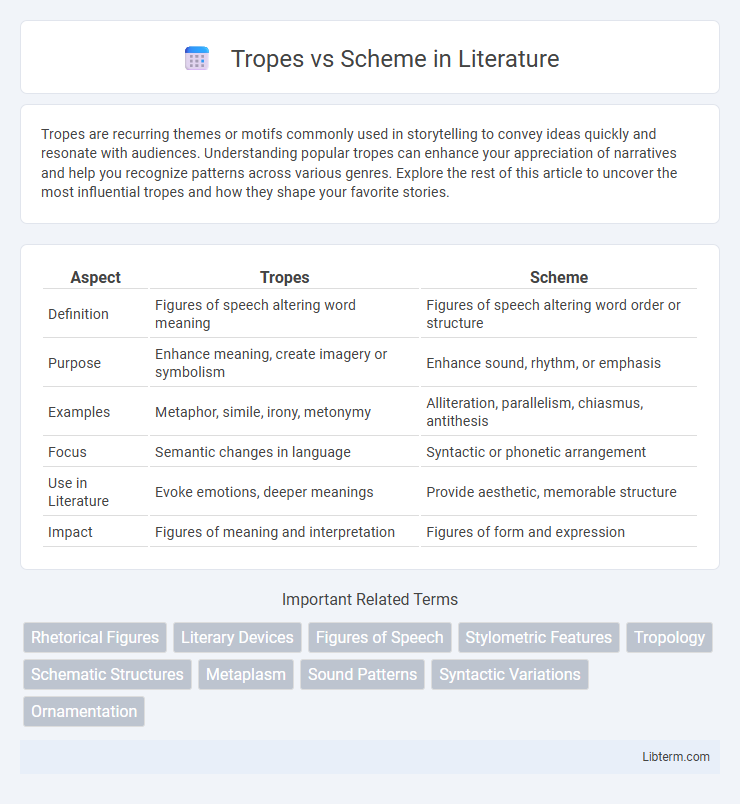Tropes are recurring themes or motifs commonly used in storytelling to convey ideas quickly and resonate with audiences. Understanding popular tropes can enhance your appreciation of narratives and help you recognize patterns across various genres. Explore the rest of this article to uncover the most influential tropes and how they shape your favorite stories.
Table of Comparison
| Aspect | Tropes | Scheme |
|---|---|---|
| Definition | Figures of speech altering word meaning | Figures of speech altering word order or structure |
| Purpose | Enhance meaning, create imagery or symbolism | Enhance sound, rhythm, or emphasis |
| Examples | Metaphor, simile, irony, metonymy | Alliteration, parallelism, chiasmus, antithesis |
| Focus | Semantic changes in language | Syntactic or phonetic arrangement |
| Use in Literature | Evoke emotions, deeper meanings | Provide aesthetic, memorable structure |
| Impact | Figures of meaning and interpretation | Figures of form and expression |
Understanding Tropes and Schemes: Definitions
Tropes and schemes are fundamental rhetorical devices used to enhance language by altering meaning and structure. Tropes involve a deviation from the ordinary meaning of words to create figurative or imaginative expressions, such as metaphors, similes, and irony. Schemes, on the other hand, manipulate the standard word order or pattern to produce stylistic effects, including parallelism, chiasmus, and anaphora.
Historical Evolution of Tropes and Schemes
Tropes and schemes have evolved significantly from their origins in classical rhetoric, where Aristotle and Quintilian first codified these figures of speech to enhance persuasion and artistry in oratory. During the Renaissance, the invention of the printing press facilitated the spread of rhetorical theory, allowing Tropes and Schemes to influence literary styles across Europe more broadly. In modern linguistics and literary criticism, these rhetorical devices are analyzed as fundamental tools for semantic variation and cognitive engagement in both spoken and written texts.
Key Differences Between Tropes and Schemes
Tropes involve a change in the ordinary meaning of a word or phrase to create a rhetorical effect, such as metaphors, similes, and irony, while schemes primarily manipulate sentence structure or word order for stylistic impact, including parallelism, antithesis, and chiasmus. Tropes often focus on semantic shifts and figurative language, whereas schemes emphasize syntactic arrangement and linguistic patterns. Understanding these distinctions is crucial for analyzing rhetorical strategies in literature and persuasive writing.
Common Examples of Tropes in Literature
Common examples of tropes in literature include metaphors, similes, and hyperbole, which enhance vivid imagery and emotional impact. Personification brings life to inanimate objects, enriching narrative depth, while irony introduces contrast between expectations and reality, often creating humor or tension. Symbolism uses objects or actions to represent broader themes, adding layers of meaning to the text.
Popular Scheme Techniques in Rhetoric
Popular scheme techniques in rhetoric include parallelism, antithesis, and anaphora, each enhancing the rhythm and emphasis of speech or writing. Parallelism involves repeating the same grammatical structure to create balance and clarity. Antithesis juxtaposes contrasting ideas in a balanced format, while anaphora repeats the same word or phrase at the beginning of successive clauses to reinforce a message.
The Role of Tropes in Shaping Meaning
Tropes play a crucial role in shaping meaning by transforming ordinary language into metaphorical expressions that evoke deeper cognitive and emotional responses. Through devices such as metaphor, metonymy, and irony, tropes allow speakers and writers to convey complex ideas succinctly and persuasively. Understanding the function of tropes enhances interpretive skills and enriches the analysis of rhetorical and literary texts.
How Schemes Influence Sentence Structure
Schemes, as rhetorical devices, primarily manipulate the ordinary arrangements of words to create distinctive sentence patterns that enhance emphasis and clarity. By altering syntax through techniques like parallelism, antithesis, and chiasmus, schemes influence sentence rhythm and balance, making prose or speech more engaging and memorable. This structural variation helps writers and speakers highlight key ideas and evoke emotional responses from their audience.
Tropes and Schemes in Modern Media
Tropes and schemes in modern media serve as fundamental rhetorical devices that shape narratives and audience engagement by manipulating language and structure. Tropes such as metaphors, irony, and hyperbole create vivid imagery and emotional resonance in film, television, and literature, enhancing thematic depth and character development. Schemes, including parallelism, chiasmus, and anaphora, provide rhythm and emphasis, driving home key messages and making content more memorable and persuasive across various digital platforms.
Practical Uses: Incorporating Tropes and Schemes in Writing
Incorporating tropes and schemes in writing enhances clarity and emotional impact by structuring language to engage readers effectively. Tropes like metaphor and irony facilitate vivid imagery and nuanced meanings, while schemes such as parallelism and anaphora create rhythm and emphasis for memorability. Mastering these rhetorical devices improves persuasion and storytelling, making content more compelling and accessible across diverse audiences.
Conclusion: The Importance of Tropes vs Schemes in Communication
Tropes and schemes play a crucial role in enhancing clarity, engagement, and persuasion in communication. Understanding the distinct functions of tropes, which involve figurative language, and schemes, which focus on structural deviations, allows speakers and writers to craft compelling and memorable messages. Mastery of these rhetorical devices significantly enriches the effectiveness and impact of both written and spoken discourse.
Tropes Infographic

 libterm.com
libterm.com